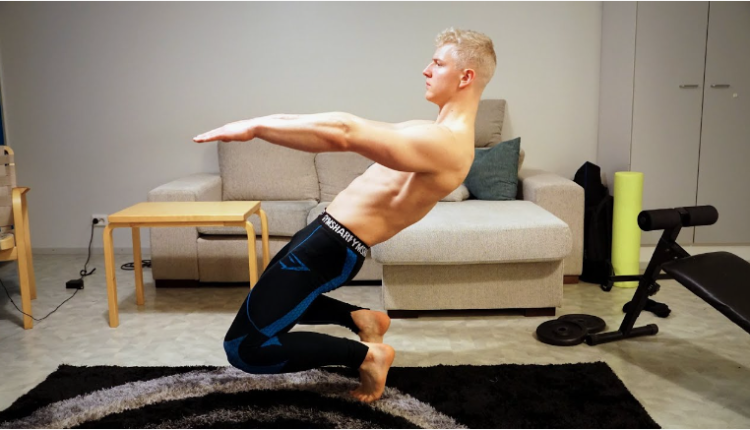Sissy Squats: The Forgotten Exercise for Ripped Thighs.
Sissy Squats: The Forgotten Exercise for Ripped Thighs. The favorite movement of bodybuilding “iron guru” Vince Gironda.
What is a Sissy Squat
The Sissy Squat is an exercise that develops the muscles of the front of the thigh. Unlike a regular squat, in which a person bends at the hip joints, when performing a Sissy, only the knees and ankles work, and the hips and back remain in one line throughout the exercise. To maintain balance, the body leans back strongly.
It is not entirely clear why the exercise has such a strange name. There is a theory that it was named after the mythical king Sisyphus, who had to roll a stone up a mountain as punishment. In English, his name is written as Sisyfus, so perhaps this version is true.
It is not known who invented the Sissy squat, but the exercise gained popularity thanks to American bodybuilder Vince Gironda. The legendary trainer nicknamed the Iron Guru believed that such squats were much better for developing leg muscles than traditional squats with a barbell on the back.
In the 1960s–80s, the Sissy squat was popular among high-level bodybuilders and was often used to develop the quads. By the 1990s, the Gironda’s fame had waned and the exercise was slowly forgotten.
Is it true that sissy squats are effective in developing quadriceps?
We were unable to find any studies in which scientists tested the level of activation of different muscles in the Sissy Squat or compared it to other exercises. However, based on the specifics of muscle activity, we can make some assumptions.
The quadriceps consists of four heads: lateral, medial, intermediate and rectus. The first three cross only the knee joint, and the last one also crosses the hip joint. That is, it is involved in both knee extension and hip flexion.
Because of this feature, the rectus femoris most powerfully extends the knees only when the hip joint is not flexed. Otherwise, most of the load goes to the other heads of the quadriceps – medial and lateral. At the same time, most popular exercises, including leg presses, squats with a barbell, leg extensions in a simulator, include flexion in the hip joints.
In one study researchers tested whether the rectus femoris could be increased by changing the angle of the hips, and found that it could. Participants who performed semi-recumbent leg extensions had significantly greater muscle development in the rectus femoris than those who performed the classic version.
Thus, it can be assumed that in sissy squats the rectus femoris will indeed receive a good load. Moreover, due to the need to keep the body and pelvis in a straight position, the muscles of the core will work properly, and the lower back, on the contrary, will rest. The latter will be an advantage for those who have already overloaded their back during front squats or deadlifts .
Who Shouldn’t Try Sissy Squats
When you do a Sissy, there is a significant shear force on the knee joints, displacing the shin relative to the thigh. This is not dangerous for healthy people, since even a significant forward shift of the knees during the squat does not increase the risk of injury. Moreover, Sissys are most often performed without weights or with very light weights.
However, people with bad knees should not take risks. If you already have problems with your leg joints, develop your muscles with more gentle movements that are sure not to cause pain.
How to Prepare to Do Sissy Squats
Sissy squats are quite a difficult exercise, and not everyone can do them the first time. Therefore, it is worth starting with a simpler variation. In it, you will lower yourself into a Sissy squat and stand up from a regular squat, which is much easier.
To begin, find any stable support at the level of your waist and place your hand on it. Place your feet together, straighten your back, pull in your stomach and tighten your buttocks to ensure rigidity of the body. Then begin the exercise.
Bend your knees as shown on the left side of the photo, lean your body back and lower yourself as low as you can. Ideally, there should be no more than 10-15 cm between your knees and the floor. Then push your pelvis back, bend at the hips and come out into a regular squat, as in the center of the photo. Rise to the starting position as shown on the right and repeat from the beginning.
If the exercise does not cause discomfort in your knees and you can perform 10-15 repetitions without problems, move on to real sissy squats.
How to Do Sissy Squats

To perform this squat, you will need to hold onto some kind of sturdy support, such as a barbell rack.
Grab the support with one or both hands. Place your feet together, tighten your abs and glutes. Bend your knees, lift your heels off the floor and smoothly lower yourself into a squat. As you sit lower , lean your straight body further back. This will help you maintain your balance.
Stop when your knees are a few centimeters from the floor. Then, while still keeping your torso and pelvis in line, straighten your legs at the knees and ankles and return to the starting position.
If you are working out in a gym, you can hold the bar with both hands, having first set it at shoulder level.
For home workouts, you can use any stable furniture and even a doorway.
How else can you do sissy squats?
Sissy squats can be done with weights, as well as on a special machine.
This variation of the exercise was created by its main fan, Vince Gironda. The movement is quite difficult, so you should not try it until you can do 10-15 regular Sissy squats.
To perform this variation, you will need a barbell and a heel rest 5-10 cm high. To begin with, choose a lighter projectile , or even better, use a bodybar weighing 3-5 kg.
Please do the following:
- Take the barbell to your chest, place your heels on the stand. Tighten your abs and buttocks to keep your body rigid, bend your knees and lower yourself into a squat.
- Once you reach the bottom, bend at the hips and lower into a regular squat with the barbell across your chest.
- Move your pelvis forward and up, returning to the position you started the second phase from.
- Straighten up and repeat.
Sissy Squats on the Machine
If you have a sissy squat machine at your gym, you can use it. But because you bend at the hips as well as the knees, the rectus femoris won’t get as much work as the other quad heads.
And yet, this exercise is good for pumping up the front of the thigh. Moreover, due to the fixation of the legs, you can take a weight – a dumbbell , a barbell or a weight plate from it – and load the quadriceps even more.
First, adjust the machine. Move the pads so that they securely hold the lower part of your shins. Place the top pad just below your knees, otherwise it will limit the range of motion.
Place your shins behind the rollers and stand up straight. Then bend your legs at the hips and knees and squat until your thighs are parallel to the floor or slightly lower. Do not lean your body forward, keep it vertical or even slightly lean it back. Rise from the squat to the starting position and repeat.
If the exercise seems too easy for you, try taking a weight. For example, press a weight plate to your chest, take a kettlebell , or hold two dumbbells in your arms at your sides.
For the most advanced trainees, there is an option with a barbell on the chest.
If you are going to perform the exercise with such a weight, do not overdo it with the weight and make sure that both phases are smooth and measured, without swinging.
How to Add Sissy Squats to Your Workout
The sissy squat is no substitute for basic leg exercises like the back and front squat, leg press , or leg extension machine. If only because you won’t be able to do it with much weight.
At the same time, the Sissy Squat can be a great addition to your workout. Do one or two sets of 10-15 reps of this exercise after your main leg movements. This will help you “finish off” your quads, give your rectus femoris enough stimulus to grow, and avoid overloading your lower back.

